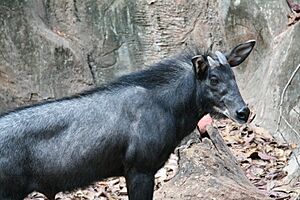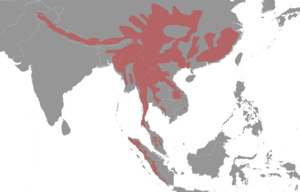Mainland serow facts for kids
Quick facts for kids Mainland serowTemporal range: Middle Pleistocene-Present
|
|
|---|---|
 |
|
| Conservation status | |
| Scientific classification | |
| Genus: |
Capricornis
|
| Species: |
sumatraensis
|
 |
|
| Synonyms | |
|
|
The mainland serow (Capricornis sumatraensis) is a cool animal related to goats and antelopes. It lives in the Himalayas, parts of Southeast Asia, and China. This animal is a type of serow, and it's quite similar to the red serow.
Contents
What is a Mainland Serow?
The mainland serow is a unique mammal. It belongs to a group of animals called serows. These animals are known for living in rocky, mountainous areas. They are often shy and hard to spot in the wild.
How Scientists Named It
Scientists give every animal a special scientific name. This helps everyone know exactly which animal they are talking about. In 1831, a person named Brian Houghton Hodgson first described a goat-like animal from the Himalayas. He called it "Bubaline Antelope" at first. Later, he changed its name to Antelope thar.
Then, in 1838, another scientist named William Ogilby created a new group for animals like the serow. He called this group Capricornis. The Himalayan serow became the main example for this new group.
Scientists also found old teeth from C. sumatraensis in a place called Khok Sung. These teeth are very old, from a time called the Middle Pleistocene. This helps us learn about the serow's history.
Physical Features
The mainland serow has a special coat. It has stiff, coarse hairs on top. These hairs protect a softer layer of fur underneath. It also has a cool mane that runs from its horns down its back.
Horns and Size
Only the male serows have horns. These horns are light-colored and about six inches long. They curve slightly backward. Both male and female serows are about three feet tall at their shoulders. They usually weigh around 200 pounds.
Where They Live and What They Like
Mainland serows live in forests on hills. They usually prefer places higher than 300 meters (about 984 feet). But in winter, they might come down to 100 meters (about 328 feet). In the Himalayas, they like elevations between 2,500 and 3,500 meters (about 8,200 to 11,500 feet).
Countries and Habitats
You can find mainland serows in many countries. These include central and southern China, Vietnam, Cambodia, Laos, Myanmar, Thailand, and the Indonesian island of Sumatra. They like to live in forested mountain ranges.
They prefer steep, rocky hills, even up to 4,500 meters (about 14,760 feet) high. But they can also live in forests and flat areas. Interestingly, they can even swim to small islands! They are pretty good at living near people too. They can survive in forests that have been changed a bit, but they try to stay away from farms.
Behaviour and Life Cycle
Mainland serows are often solitary animals. This means they usually live alone. Sometimes, you might see them in small groups. They are also very territorial. This means they protect their living space from other serows.
Reproduction
Female serows give birth to one baby at a time. They carry their young for about eight months before the baby is born. This is called the gestation period.
Protecting the Mainland Serow
The mainland serow is a protected animal. It is listed under CITES Appendix I. CITES is an international agreement that helps protect endangered plants and animals. Appendix I means that trading these animals is generally not allowed. This helps to keep them safe in the wild.


